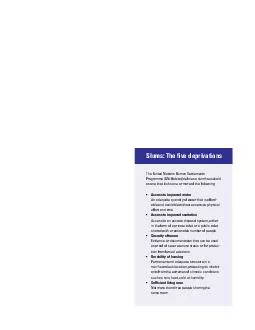

These typically include tenements houses that have been subdivided boarding houses squatter settlements vacant plots or buildings occupied by people who do not own rent or have permission to use them and ille gal subdivisions in which a house or hut ID: 76096
Download Pdf The PPT/PDF document "Children in an increasingly urban world ..." is the property of its rightful owner. Permission is granted to download and print the materials on this web site for personal, non-commercial use only, and to display it on your personal computer provided you do not modify the materials and that you retain all copyright notices contained in the materials. By downloading content from our website, you accept the terms of this agreement.
Children in an increasingly urban world 5Impoverished people, denied proper housing and security of tenure by inequitable economic and social policies and regulations governing land use and management, resort to renting or erecting illegal and often ramshackle dwellings. These typically include tenements (houses that have been subdivided), boarding houses, squatter settlements (vacant plots or buildings occupied by people who do not own, rent or have permission to use them) and illegal subdivisions (in which a house or hut is built in the backyard of another, for example). Squatter settlements became common in rapidly growing cities, particularly from the 1950s onward, because inexpensive housing was in short supply. Where informal settlements were established on vacant land, people were able to build Illegal dwellings are poor in quality, relatively cheap – though they will often still consume about a quarter of household income – and notorious for the many hazards they pose to health. Overcrowding and unsanitary conditions facilitate the transmission of disease – including pneumonia and diarrhoea, the two leading killers of children younger than 5 worldwide. Outbreaks of measles, are also more frequent in these areas, where population density is high and immunization levels are low.In addition to other perils, slum inhabitants frequently face the threat of eviction and maltreatment, not just by landlords but also from municipal authorities intent on ‘cleaning up’ the area. Evictions may take place because of a wish to encourage tourism, because the country is hosting a major sporting event or simply because the slum stands in the way of a major redevelopment. They may come without warning, let alone consultation, and very often proceed without compensation or involve moving to an unfeasible location. The evictions established economic and social systems and support networks – the existence of which should come as no surprise if one ponders what it takes to survive and advance in such challenging settings. Even those who are not actually evicted can suffer signi cant stress and insecurity from the threat of removal. Moreover, the Despite their many deprivations, slum residents provide at least one essential service to the very socilabour. Some of it is formal and some undocumented, but almost all is low-paid – for example, as factory hands, shop assistants, street vendors and domestic workers. Programme (UN-Habitat) de nes a slum household An adequate quantity of water that is afford-able and available without excessive physical Access to improved sanitation Access to an excreta disposal system, either Security of tenure Evidence or documentation that can be used tion from forced evictionsDurability of housing Permanent and adequate structure in a non-hazardous location, protecting its inhabit-Suf cient living area Not more than three people sharing the A woman and child walk among the ruins of a low-income neighbourhood © UNICEF/NYHQ2006-2606/Michael Kamber